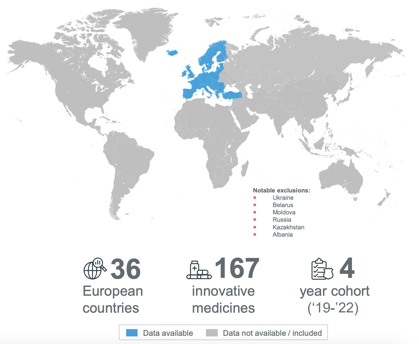New data from EFPIA on access to medicines for patients across Europe

Three reports published by EFPIA, show that disparities in the time it takes for European patients to access new medicines persist. Across the region, the average time to patient access is 531 days. Ranging from 126 days in Germany to 804 days in neighbouring Poland.
The data shines a light on the delays and barriers to access that European patients face. Ensuring that medicines reach citizens regardless of where they live in Europe, is not only a shared goal but a shared responsibility. The current situation, where patients in one European country can wait more than 6 times as long as patients in a neighbouring country for the same medicines must be addressed.

The reasons for unavailability and delays, explored in the CRA Report are multifactorial, even before a medicine is approved in Europe, slow regulatory processes can lengthen the time it takes for new medicines to get to patients.
Delays and barriers to access are often due to a combination of factors. For example, the speed of health technology assessments, different reimbursement processes or additional layers of regional and local decision making. Duplicative or inconsistent evidence requirements can also cause delay or a lack of availability. For example, different countries, HTA bodies and payers may require different endpoints, or some accept real world evidence where others do not.
The use of external reference pricing (ERP) also causes delays and unavailability. Several countries don’t start their national pricing and reimbursement processes until they have access to the reimbursement decisions from several other European countries.
The European Access Hurdles Portal generates even more detailed insights into the reasons behind the delays to patients getting access to medicines. Data in the portal report covers 66 medicines - that received a centrally authorised marketing authorisation between January 2021 and June 2023.
Whereas the Patient W.A.I.T. Indicator documents the time from EU marketing authorisation to the reimbursement of medicines in Member States, the portal allows us to look in greater detail at the timings of different steps in that process. The data shows that the majority (71%) of the time between EMA approval and reimbursement occur after a product has been filed for pricing and reimbursement (P&R). The remaining 29% happens prior to filing for P&R.
The Portal also highlights issues in all the different categories of root causes: health system infrastructure, economic viability, P&R process and value assessment. However, there are differences between regions of Europe: delays in filing in Western Europe were largely due to the value assessment process and evidence requirements, while delays in Eastern and Southern Europe were mostly due to health system constraints and the corresponding impact this has on the economic viability for manufacturers to launch innovative medicines.
When looking at why companies have not filed for pricing and reimbursement in the five countries with the lowest filing rate (Greece, Latvia, Lithuania, Cyprus, and Malta), specific reasons stand out. For example, in Greece, ‘Country filing requirements’ were found to be a major contributor to the low rate of filed products; this is likely due to the requirement in Greece that products only be considered for HTA if they are reimbursed in at least five of a list of 11 Western European countries.[4] The granularity of the information demonstrates the value of the Portal in increasing the transparency of root causes of delays so, together we can move to pragmatic solutions that work for patients and help address Europe’s health inequalities.
2024 Patient W.A.I.T. Indicator.
CRA Report on the root causes of unavailability and delays to innovative medicines.
2nd Report form the European Access Hurdles Portal.
